In the fast-moving world of B2B SaaS, affiliate referral programs are quickly becoming key to growth. With a market value exceeding $17 billion in 2023 (Google), experts predict it could reach $40 billion by 2030 (Astuteanalytica). Not surprisingly, more than 81% of brands are already applying this growth loop (Authorityhacker). What works incredibly well, especially in B2C e-com, remains untapped for B2B SaaS.
This guide aims to demystify affiliate referrals, offering practical advice, tested strategies, and innovative approaches designed specifically for high-growth B2B SaaS companies. Whether you're starting from scratch or looking to improve your existing program, this guide will provide the answers you need:
- Does an affiliate program make sense for me and my product?
- What types of affiliate referrals exist, and what are the pros and cons?
- How to launch an affiliate referral program?
- How and where to identify affiliates?
- How to promote an affiliate program?
- How to scale and maintain it?
- What are KPIs to look for?
What are affiliate referrals?
We generally distinguish between user referrals and partner referrals. Affiliate referrals are a subcategory of partner referrals.
If we take one step back and look at the theoretical foundation of growth loops Casey Winter and Kevin Kwok defined affiliate referral programs as a subtype of Paid Growth Loops.
New user sign-ups generate revenue and are reinvested in ads or content suppliers or partners distribute. The primary fuel of this loop is revenue.

Based on this theoretical foundation, we can define affiliate referral programs as a growth channel where businesses incentivize external partners (affiliates) to promote their products or services to a broader audience.
These affiliates, from individuals to companies, earn a commission or other rewards for each customer or sale they generate through their referral links.
Now that you understand what affiliate referral programs are, let’s have a closer look at what’s in it for you.
Why should I invest in an affiliate referral program?
Affiliate referrals aim to leverage cost-effective, scalable growth.
This approach taps into the networks of trusted affiliates to increase product visibility and credibility, driving targeted leads and conversions.
With affiliates generally paid on a performance basis, it ensures zero payback time and a high ROI by focusing expenditure on proven results.
Moreover, it enhances brand reach within niche markets through partners with established audiences, facilitating efficient market penetration and customer acquisition with minimal upfront costs.
Some stats in a nutshell:
- As of May 19, 2023, affiliate programs drove 16% of all online orders in the United States (Demandsage)
- A good 65% of retailers see up to a 20% increase in yearly revenue through affiliate marketing. Nearly 60% of merchants make $5 million, showing great revenue potential with good affiliate marketing strategies (Demandsage)
- More than 80% of brands use affiliate marketing programs, allocating around 10% of their marketing budget to it (Forrester)
- B2B affiliate programs account for 40.68% of all affiliate programs used by marketers, with SaaS products paying the highest commissions (Authorityhacker)
Before we try to understand if affiliate referral programs are for you, let’s have a deep dive into the most prominent types of affiliates and see which type of company is most suited for them.
What types of affiliate referral programs are suited for you?
We generally see the following 2 emerging forms of affiliate referral programs.
- Affiliate content creators: Online content creators who place affiliate links into their copy, visuals, or podcasts.
- Affiliate hubs: Specialized websites that provide access to affiliates or enable affiliate link listings.
The below overview compares various subcategories of these two affiliate forms (the list is non-exhaustive) and indicates which one could work best for you.
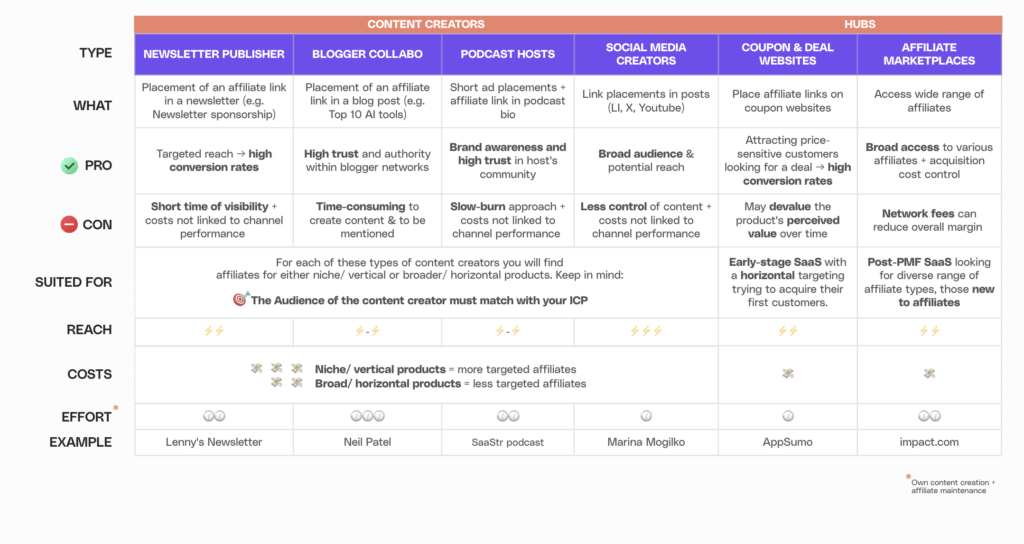
Let’s move on and see whether an affiliate program is right for you.
Is an affiliate program right for me?
Deciding if an affiliate referral program is right for your B2B SaaS company hinges on the product's nature, complexity, and market fit.
Low to Medium Friction Products: These products are easily accessible (freemium or free trial product access), making them ideal for affiliate marketing. Affiliates can effectively communicate the product's benefits, appealing to a broad audience.
High-Friction Products or Narrow Audiences: These products face challenges due to their complexity or niche target market. Achieving success through affiliate marketing requires more effort, including significant upfront investment in affiliate education and a more time-consuming go-to-market strategy, relying heavily on the affiliates' influence and expertise. Choosing the right affiliate (s. Sourcing & Acquiring section) could still result in program success.
Trend-driven products: It's noteworthy that affiliates typically see a 47.16% higher earning from selecting products based on trends rather than commission rates or personal insights (Authorityhacker). This aligns with the initial point about the widespread appeal of AI tools among today's affiliates.
Natural limitation: Be aware that growth and scalability through affiliates might be naturally limited due to a shortage of suitable affiliates for your product.
In essence, while affiliate programs can significantly boost growth, their effectiveness varies based on product accessibility and audience specificity.
We’ve covered the theoretical foundation; let’s get more tactical and learn how to set up an affiliate program in 6 steps.
6 steps to a successful affiliate referral program
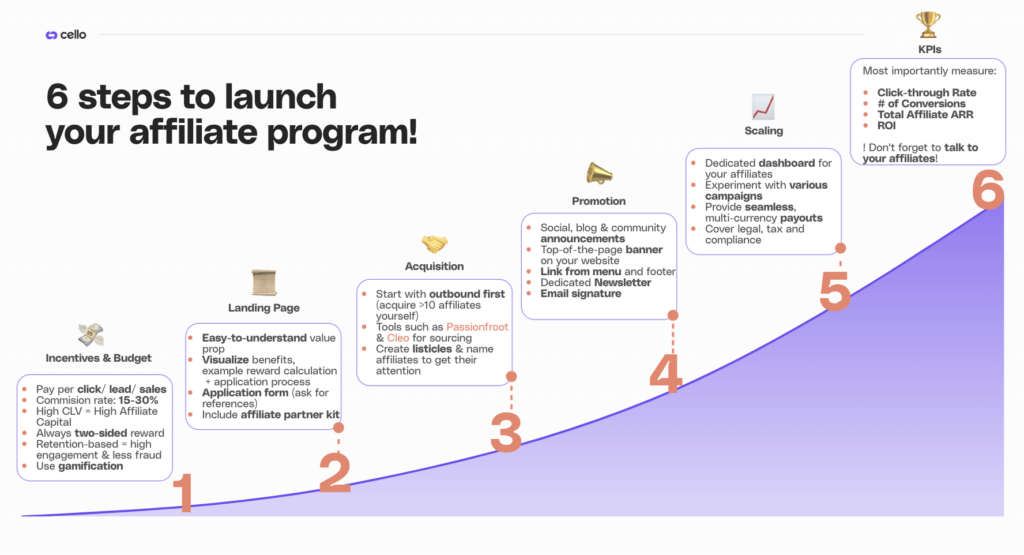
1. Setting the right incentives & budget
Incentives can have different structures to encourage partners to create high-quality content and build long-term relationships. As we’ve already learned, affiliates are typically rewarded with cash compensation, but how can you set it up? In general, we see three different forms:
- Pay-per-click: The affiliate gets a reward for every successful unique click on a referral link
- Pay-per-lead: The affiliates get a reward for an inbound lead or a specific event
- Pay-per-sale: The affiliates get a percentage of the revenue generated by new paying customers
Affiliates often receive a percentage of the sale (pay-per-sale) or a pay-per-click, but how high should the percentage be?
Saas-based products tend to pay the highest commission fees for affiliates. Between 20% to 70% commission is typically paid to SaaS affiliates based on the nature of the product (authorityhacker). The rate we see at Cello typically ranges from 15% to 30%. Remember that the higher your CLV, the higher the max payout can be, but the commission fee is lower:
Calculate the right affiliate budget:
- Average Customer Lifetime Value (CLV): Understand how much revenue the average customer brings in over their lifetime.
- Profit Margins: Consider your profit margins on the products or services being promoted. You'll want to ensure that you're still maintaining a healthy profit after paying out commissions.
- Market Competition: Research what your competitors offer in their affiliate programs. To attract top affiliates, your offer needs to be competitive.
- Program Management Costs: Don't forget to account for the costs of managing the affiliate program, including software, personnel, and marketing materials.
- Estimated Acquisition through Affiliates: Estimate how many new customers you expect to acquire through the affiliate program.
- Trial and Error: Start with a budget you're comfortable with, and adjust as you go. Affiliate marketing can require some experimentation to find the right balance. You can also set up two campaigns and do A/B testing to better understand what incentivizes your user base.
🧮 Example Calculation:
If your SaaS product has a CLV of $1,000 and a target profit margin of 70%, and you're aiming for a 30% margin after affiliate commissions, you can afford to pay up to $400 in commissions ($1,000 * 70% - $1,000 * 30%).
Some other key variables you should consider are:
- Two-sided rewards: Not only incentivizing the affiliate but also the referee with a discount makes it even more attractive for both parties to a) participate in the affiliate program b) incentivize new users to sign up for your product.
- Retention-based pay-per-sales: For attaining high-quality affiliates, offer revenue shares that extend over time, with initial and possibly reduced ongoing payments. Make it recurring to fit the nature of SaaS subscription models (e.g. 20% of the monthly generated revenue). One added benefit with the recurring reward model: It naturally serves as a fraud deterrent (assuming a closed, fraudulent deal “churns” after a month).
- Payout Thresholds: Establish minimum earnings for withdrawal to motivate continuous content creation, like Fiverr's $100 threshold.
- Gamification and Incentives Tiering: Introduce levels of rewards for achieving certain milestones and enhance engagement through gamification, like leaderboards and performance boosters.
You have defined your incentive scheme and affiliate budget. Great, now it’s time to build out your affiliate referral landing page.
2. Preparing your affiliate program landing page
Creating a landing page on your website is key for any affiliate program. It should describe the benefits and structure of your program, your reward model, and payout terms (e.g. referral-based, one-off, lifetime). For example, Fellow does a great job. Consider including:
An easy-to-understand value proposition
Point out what your product is about and include visuals and trust elements (e.g. customer logos, G2 rating).
Visualize what’s in it for them
Let affiliates know how much they can earn with your program and provide some example calculations.
Describe the application process
Make sure to describe the application process in an easy, straightforward way and highlight its benefits.
Create a dedicated sign-up/ application form
You need to create a signup form where affiliates can apply. Each field in the signup form should be a criterion that helps you segment affiliates into relevance buckets (e.g. by audience size, vertical, posting frequency, and geolocation).
Provide an affiliate partner kit
Create an affiliate partner kit (s. tl;dv) to reduce affiliates’ referral effort. Don’t give them simply a plain copy and visual assets, but go beyond that including also post theme ideas, posting frequency to vary their content, and specific dos/don'ts guidelines.
Some must-have assets to include in the kit are:
- Logos, brand colors, and fonts.
- Product screenshots and UI.
- Marketing infographics, one-pagers, or decks
When you see your affiliates as de facto members of your external marketing & sales team, you’ll realize you need to approach this as if you were empowering them with the tools to make great content for your brand.
Typefully does a great job at this by giving their affiliate partners not just writing prompts and branded assets for each product use case, but also a changelog listing ongoing product updates, so they can generate constant content ideas as well as examples of successful affiliate content to educate them on what good and great content look like.
3. Sourcing and acquiring affiliates - outbound first
Identifying the right affiliates for your product is crucial. Even though you end up running inbound and outbound in parallel, always start with outbound.
If you’re just starting and you (or your brand) don’t have an audience yet, you can search for your affiliates on dedicated discovery platforms. Tools like Passionfroot are great for bootstrapping your initial affiliate base.
You can filter by audience size, vertical of interest, and social channel they use, and keep track of all your outreach communications — from the first touch to follow-up, proposal, and spend — all in one neat dashboard.
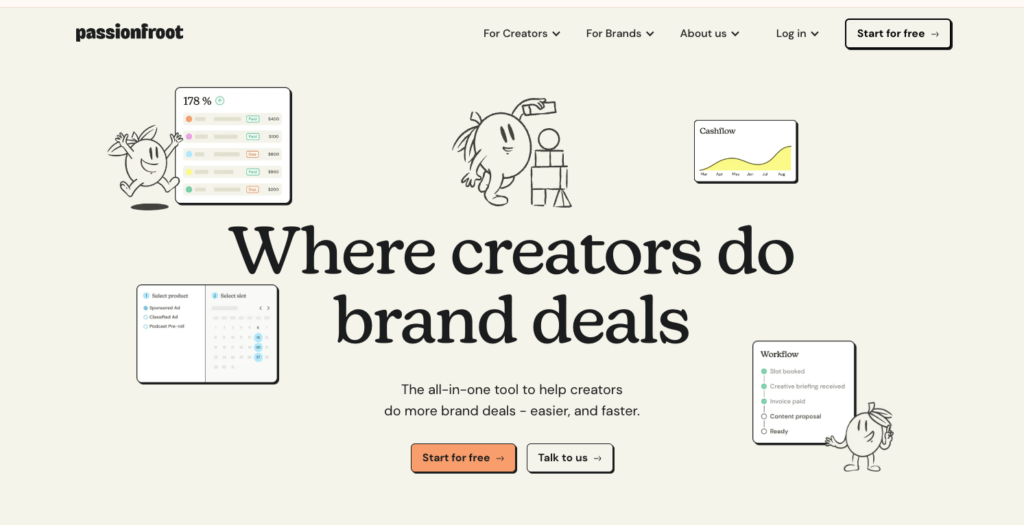
💡 Pro Tip:
It’s recommended to add scoring criteria to your top affiliates as you go, understanding which format, channel, and audience mix works best for you. You can also use Chrome extensions like UpDog to monitor their effective social engagement, which might differ from what each creator tells you about them.
Tools like Kleo, Taplio (Alex Affiliate Link Example), or TweetHunter are also helpful for discovering new, larger affiliates with high engagement on LinkedIn and X beyond the aforementioned discovery platforms.
When you identify these affiliates, a great tactic to attract their attention is to create a listicle as an X or a LinkedIn post praising them for their work; this is a great tactic to grab their attention while showing that you’re also part of their niche, showcasing your thought leadership.
If they do engage, reach out to them directly on the channels where they publish (LinkedIn, X, Youtube, TikTok) to ask if they’d be interested in a collaboration; keep it casual and aim to discuss in more detail on a call.
What’s next? Do I need a contract?
This highly depends on whether you run the program yourself or via a professional affiliate platform. Some of the larger affiliates might ask you to forward them a standard contract. If you do it yourself, it’s helpful to start from a template and customize based on your needs with your legal team. If you use a platform (like Cello), they usually take care of it.
Once you have bootstrapped your initial affiliate partners with outbound approaches and the initial traffic is kicking in, you can start productizing your inbound motion in parallel, which we will dive into more in the next section.
4. Constantly promote your affiliate program - Inbound
First affiliates have been acquired. Now it’s time to start your inbound motion. A few recommended tactics are:
- Run organic social, blog, and community announcements (e.g. Slack communities)
- Embed website top-of-the-page banner highlighting your new partner program
- Main navigation and footer backlinks should lead to your partner page
- Have some of your existing partners share about their participation in your program on social . Reward them for adding more affiliates to the program.
- Dedicated newsletter and/or inclusion in your nurture emails about the program
- Inclusion of your program in your user profiles (LD) and/or email signature
As you usually nurture and engage with leads on an ongoing basis, don’t forget to keep your affiliates engaged in the program and regularly create content for them.
5. Scale and maintain
Managing multiple affiliates, incentive schemes and campaigns
When you set up your program, it’s key to add, manage, and incentivize partners with granular controls, and at scale. Whether you set up the affiliate referral program yourself or choose a third-party solution to support, take the following key considerations into account:
- Dedicated Affiliate Dashboard. When you find an affiliate, give them access to a dedicated, individual partner portal to track their payouts, earnings, affiliate links, and activity, and even have leaderboards to compare themselves to other affiliates. Create automated monthly activity update newsletters. This will help affiliates create a habit around sharing your product, access your partner kit for new content ideas, and encourage healthy competition within their community.
- Multi-Campaign Support. Seek to create multiple campaigns for different affiliates — depending on their category, vertical of interest, or even audience size — each with a different reward structure and type — so you can best tailor the reward structure to appeal to different partners.
- Seamless, Multi-Currency Payouts. Offer various payout options (e.g. PayPal, bank transfer) in various currencies.
Be aware of legal, tax, and compliance considerations.
Navigating legal, tax, and compliance considerations is key and often forgotten when deploying referral programs.
Affiliates must disclose their relationship with the company clearly to maintain transparency. Comply with advertising standards and avoid misleading promotions.
When taking care of the payouts, ensure you have the right details from the affiliates (e.g. individual vs. business) to comply with country-specific tax reporting. You also need to ensure that you provide a proper invoice or credit note to the affiliates.
6. KPIs and benchmark
Finally, you should always look at the right KPIs to measure and continuously improve your affiliate referral program. Tracking and analyzing these metrics allows you to decide if affiliate programs are a good fit for your GTM strategy (-> Free GTM Workbook).
Essential metrics that serve as the compass guiding this journey are:
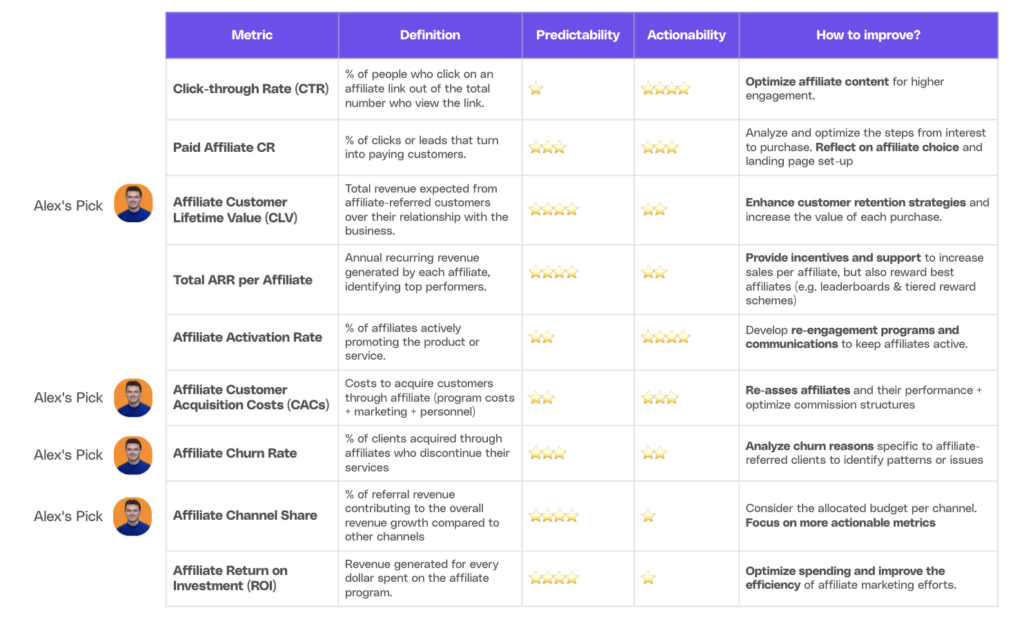
💡 Pro Tips:
Choose the right KPIs for your stage: Early on, focus on leads and conversions. As your program matures, shift focus to revenue, CLV, and individual affiliate performance.
Track trends over time: KPIs are most useful when analyzed consistently. Look for patterns that could inform optimizations to your program.
Don't forget qualitative data: Talk to your affiliates, gather feedback on the program, and identify areas for improvement.
Closing thoughts
Affiliate referral programs have the potential to be a significant growth channel for B2B SaaS companies. They are scalable and cost-effective.
If affiliate programs are successful for you, depends on multiple criteria:
- Product complexity & market fit
- Structure of the affiliate program
- Availability of suited potential affiliates
- Your ability to enable & engage your affiliates
- Your ability to scale the program
Finally, don’t forget the synergies between user and affiliate referrals. Layer user referrals on top of affiliates once you have reached a significant monthly active user base (e.g. >1000 MAUs).
Resources
Related Guides

Complete Guide to your B2B Referral Program
Want to get started with B2B referrals? Check out our complete guide to your B2B referral ...

How to use incentives to drive velocity of your growth loops
This article is written together with Wes Bush, founder and CEO of ProductLed and one of the ...
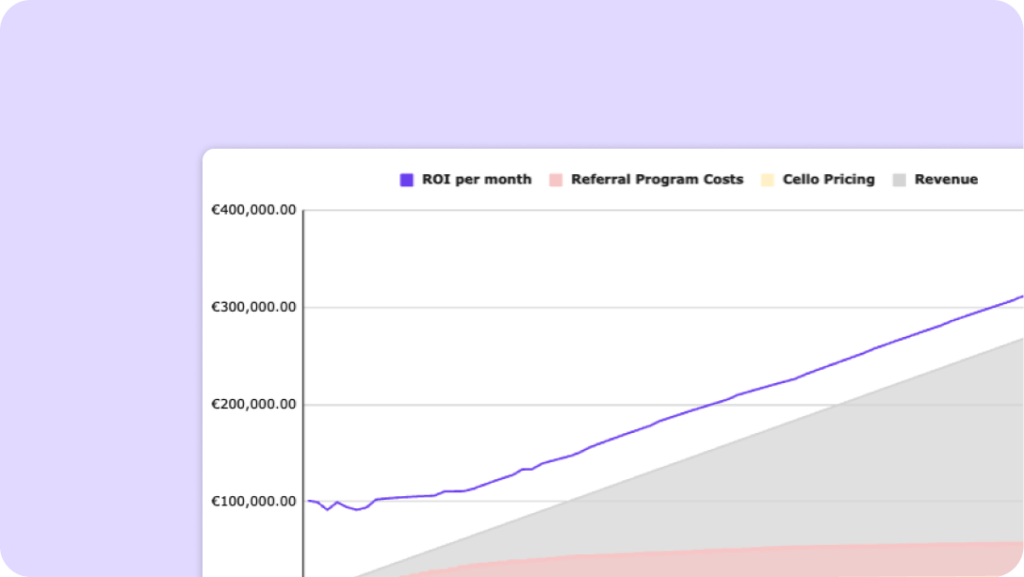
PLG SaaS Referral ROI Calculator
Learn how to estimate and prove the ROI of your PLG Referral Program

